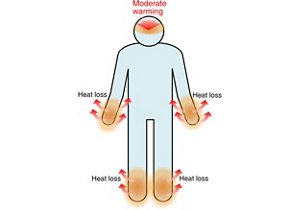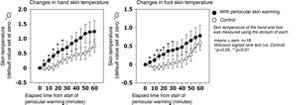Effects of periocular skin warming on sleep initiation
- Increased body heat loss confirmed -
This is an English translation of the a news release in Japanese on August 22nd.
In a study presented in 2017, the Personal Health Care Research Laboratory of Kao Corporation (President and CEO, Michitaka Sawada) reported that moderate warming of the periocular skin region before bedtime improved the quality of sleep, e.g., ease with quickly falling asleep, in individuals with mild sleep difficulties*1 ,*2 . In the present study, Kao researchers focussed on body temperature, which is known to be closely related to sleep, and attempted to clarify the mechanism related to ease with falling asleep. Our results indicated that heat loss from the body is enhanced as skin temperature of the hands and feet becomes elevated by moderate warming of the periocular skin region (Fig. 1). That physiological change is similar to body changes related to falling asleep and considered likely to have a favorable effect on sleep initiation.

Fig. 1. Schematic image showing body heat loss enhanced by periocular skin warming.
The contents of this study were presented at the 44th Annual Meeting of the Japanese Society of Sleep Research (June 27-28, 2019, Nagoya). A portion of the research findings have been published in Scientific Reports (e-journal) of the Nature Publishing Group*3 .
-
* 1 Effects of bedtime periocular warming on sleep status in adult female subjects: A pilot study, Evid Based Complement Alternat Med, 2017.
doi: 10.1155/2017/641943
https://www.hindawi.com/journals/ecam/2017/6419439/ -
* 2 Effects of bedtime periocular and posterior cervical cutaneous warming on sleep status in adult male subjects: a preliminary study, Sleep Biol Rhythms, 2018.
doi: 10.1007/s41105-017-0129-3
https://link.springer.com/article/10.1007/s41105-017-0129-3 -
* 3 Periocular skin warming elevates the distal skin temperature without affecting the proximal or core body temperature, Scientific Reports, 2019. doi: 10.1038/s41598-019-42116-x
https://www.nature.com/articles/s41598-019-42116-x
Background
Sleep is essential for human life. However, difficulties with sleeping have been reported for approximately one in five of the general adult population in Japan . Problems with sleep not only lower labor productivity, but can also lead to a variety of other complications such as depression and lifestyle-related diseases. In our search for solutions, Kao Corporation has been conducting studies focused on body temperature, which is known to be closely related to sleep.
Humans maintain a higher core body temperature in a waking state for performing actions. In contrast, that temperature is lowered during sleep to provide rest for the body as well as the brain. The mechanism for reduction of core body temperature is mainly determined by heat loss from the skin of the extremities through elevation of hand and foot skin temperature, which is causally involved in sleep propensity. This phenomenon is the reason why the warm hands of a baby are commonly thought to be a signal that they are sleepy. Furthermore, it is considered that individuals with cold hands and feet have difficulties with falling asleep due to the lower skin temperature in those extremities, resulting in reduction in heat loss.
Effects of periocular skin warming on initiation of sleep
Kao Corporation previously reported that moderate warming of the periocular skin region before bedtime improved subjective and objective sleep quality, such as findings of "easily falling asleep", in adults with mild sleep difficulties*1 ,*2 . As for the possible mechanism linking periocular skin warming with sleep, both psychological factors with effects on relaxation and physiological changes through body temperature were considered likely to influence sleep. To clarify the psychological and physiological effects of periocular skin warming, Kao researchers performed evaluations with use of a heat-generating sheet to safely and moderately warm the periocular skin region.
The subjects were 19 healthy males. This study was conducted in an experimental laboratory during daytime hours. They were asked to rest and maintain wakefulness for 60 minutes on a bed while moderately warming the periocular skin region with the same type of heat generating sheet used in our previous study. Core body (rectal) temperature, skin temperature on the hand (dorsum side) and foot (dorsum side), and skin temperature on the trunk (infraclavicular region) were measured. Additionally, subjective evaluations (warmth, pleasantness, sleepiness) were obtained verbally, and electroencephalography and electrocardiography were also used. Heat loss was measured by assessing the skin temperature difference between the trunk and hands and feet (hand and foot skin temperature – trunk skin temperature).
The following results were confirmed following application of moderate periocular warming:
1. Subjective pleasantness and sleepiness were increased.
2. Skin temperature in the hands and feet were higher in subjects with periocular skin warming in comparison to the control group*4 (Fig. 2).
3. Skin temperature gradient between the trunk and hands and feet was increased in comparison to the control, indicating enhancement of heat loss to outside of the body (Fig. 3).
-
* 4 A sheet with no heat-generating effect was used in the control group.
Changes shown in 2 and 3 are similar to physiological changes in the body when falling asleep.

Fig. 2. Changes in hand and foot skin temperature.

Fig. 3. Changes in skin temperature of hand and foot as compared with trunk.
Accordingly, it is considered likely that periocular skin warming has favorable effects on sleep initiation. On the basis of these findings as well as those of previous studies, Kao researchers consider that both psychological and physiological effects for relaxation induced by moderate periocular skin warming lead to more easily falling asleep.
The present study was performed under the guidance and cooperation of Professor Makoto Uchiyama, Department of Psychiatry, Nihon University School of Medicine.
Kao Corporation will continue to study the relationship between sleep and body temperature for development of future applications and to deepen our understanding of sleep problems.
About Kao
Kao creates high-value-added products that enrich the lives of consumers around the world. Through its portfolio of over 20 leading brands such as Attack, Bioré, Goldwell, Jergens, John Frieda, Kanebo, Laurier, Merries and Molton Brown, Kao is part of the everyday lives of people in Asia, Oceania, North America and Europe. Combined with its chemical division, which contributes to a wide range of industries, Kao generates about 1,500 billion yen in annual sales. Kao employs about 33,000 people worldwide and has 130 years of history in innovation. Please visit the Kao Group website for updated information.
Media inquiries should be directed to:
Corporate Communications
Kao Corporation
